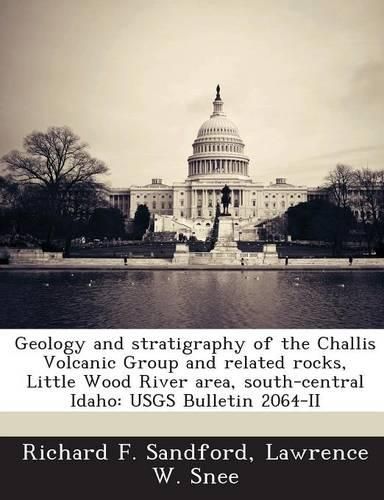Readings Newsletter
Become a Readings Member to make your shopping experience even easier.
Sign in or sign up for free!
You’re not far away from qualifying for FREE standard shipping within Australia
You’ve qualified for FREE standard shipping within Australia
The cart is loading…






The southwestern part of the Challis volcanic field occupies the valley of the Little Wood River and its tributaries in the Hailey and Idaho Falls 1 2? quadrangles of south-central Idaho. The Little Wood River area is a structurally controlled topographic basin that is partly filled by Eocene Challis Volcanic Group and younger rocks. Rock types in the Challis Volcanic Group of the Little Wood River area include, in order of decreasing abundance, andesite lava flows and tuff breccia, dacite lava flows and flow breccia, volcaniclastic sedimentary rocks, lithic tuff, nonvolcanic conglomerate, and rhyolite dikes. A basal nonvolcanic conglomerate, that locally rests on upper Paleozoic sedimentary rocks at a regional unconformity, was deposited prior to eruption of volcanic rocks. Andesite was the first volcanic rock erupted and is a voluminous sequence as thick as 3,000 ft (1,000 m). Locally thick volcaniclastic sedimentary rocks accumulated in topographic lows. A sharp transition marks the beginning of dacite eruption from fissures and flow-dome complexes. Dacite flows and breccias are as thick as 2,000 ft (600 m). An upper volcaniclastic unit was deposited in paleotopographic lows following emplacement of the main dacite unit. Next, a widespread, distinctive, lithic rich ash flow tuff, correlated with the tuff of Stoddard Gulch, was deposited over much of the area. Deposition of the tuff was followed by eruption of thin andesite and dacite lava flows and deposition of conglomeratic sedimentary rocks. The entire sequence was then intruded by a dacite flow-dome complex composed of at least three separate intrusions. The Challis Volcanic Group in the study area is calc alkaline. Andesitic rocks are typically high potassium basaltic andesite, high potassium andesite, shoshonite, and banakite (latite). Dacitic rocks are high potassium dacite and trachyte. Tuffs and vitrophyres range in composition from basaltic andesite to trachyte. The paleotopographic basin in which the Challis Volcanic Group accumulated was in part structurally controlled by preexisting west and northwest trending normal faults. Paleorelief was probably more than 2,000 ft (600 m). Rocks of the Challis Volcanic Group typically dip about 36? E., probably owing to Eocene extension and (or) basin-and-range faulting and tilting. Some potential for precious and base metal hydrothermal deposits is associated with northeast trending lineaments, argillic alteration, and rhyolite dikes.
$9.00 standard shipping within Australia
FREE standard shipping within Australia for orders over $100.00
Express & International shipping calculated at checkout
The southwestern part of the Challis volcanic field occupies the valley of the Little Wood River and its tributaries in the Hailey and Idaho Falls 1 2? quadrangles of south-central Idaho. The Little Wood River area is a structurally controlled topographic basin that is partly filled by Eocene Challis Volcanic Group and younger rocks. Rock types in the Challis Volcanic Group of the Little Wood River area include, in order of decreasing abundance, andesite lava flows and tuff breccia, dacite lava flows and flow breccia, volcaniclastic sedimentary rocks, lithic tuff, nonvolcanic conglomerate, and rhyolite dikes. A basal nonvolcanic conglomerate, that locally rests on upper Paleozoic sedimentary rocks at a regional unconformity, was deposited prior to eruption of volcanic rocks. Andesite was the first volcanic rock erupted and is a voluminous sequence as thick as 3,000 ft (1,000 m). Locally thick volcaniclastic sedimentary rocks accumulated in topographic lows. A sharp transition marks the beginning of dacite eruption from fissures and flow-dome complexes. Dacite flows and breccias are as thick as 2,000 ft (600 m). An upper volcaniclastic unit was deposited in paleotopographic lows following emplacement of the main dacite unit. Next, a widespread, distinctive, lithic rich ash flow tuff, correlated with the tuff of Stoddard Gulch, was deposited over much of the area. Deposition of the tuff was followed by eruption of thin andesite and dacite lava flows and deposition of conglomeratic sedimentary rocks. The entire sequence was then intruded by a dacite flow-dome complex composed of at least three separate intrusions. The Challis Volcanic Group in the study area is calc alkaline. Andesitic rocks are typically high potassium basaltic andesite, high potassium andesite, shoshonite, and banakite (latite). Dacitic rocks are high potassium dacite and trachyte. Tuffs and vitrophyres range in composition from basaltic andesite to trachyte. The paleotopographic basin in which the Challis Volcanic Group accumulated was in part structurally controlled by preexisting west and northwest trending normal faults. Paleorelief was probably more than 2,000 ft (600 m). Rocks of the Challis Volcanic Group typically dip about 36? E., probably owing to Eocene extension and (or) basin-and-range faulting and tilting. Some potential for precious and base metal hydrothermal deposits is associated with northeast trending lineaments, argillic alteration, and rhyolite dikes.